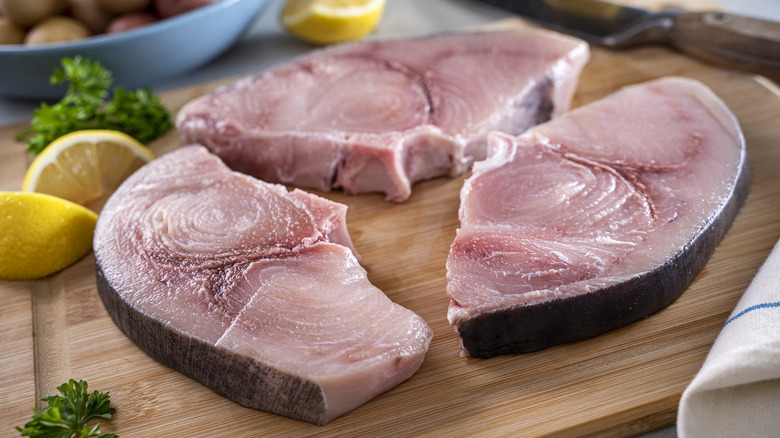Why Anthony Bourdain Stopped Eating Swordfish
We may receive a commission on purchases made from links.
Anthony Bourdain often opined about the cities he liked to visit, and the foods he loved to eat there. As much as he accentuated the positive, there were also plenty of foods Anthony Bourdain hated with a passion, and fish was one food group that didn't escape his indignation. It's not that he didn't appreciate seafood, but certain dishes — along with how restaurants served them — often met with his disapproval. For example, he espoused that the best day of the week to go to a restaurant was Tuesday, specifically because the fish wasn't as fresh over the weekends, especially when served as the "chef's special" or "catch of the day."
Earning one of the top spots, however, as some of the worst food Bourdain ever ate was an Icelandic delicacy called hákarl, which is made from fermented Greenland shark. Apparently, some things were even too much for the guy who once sought out and enjoyed eating a still-beating cobra heart. But there's one fish that, even though he had nothing against its flavor, he unequivocally stopped eating — swordfish.
In his book, "Kitchen Confidential," Bourdain explained why swordfish was off the menu: "I like it fine. But my seafood purveyor, when he goes out to dinner, won't eat it. He's seen too many of those [three]-foot-long parasitic worms that riddle the fish's flesh. You see a few of these babies — and we all do — and you won't be tucking into swordfish anytime soon."
Cook or freeze your swordfish
Not to be confused with edible land-based worms that are consumed in many cultures as a viable source of protein or a tasty snack, the parasitic worms found in ocean fish are not the same. These parasites affect not only swordfish but are also common in saltwater fish, including flounder, cod, tuna, and red snapper. If you have ever had the unpleasant experience of discovering a cod worm, then you're already familiar with these pale, skinny creatures sometimes called spaghetti worms.
According to the CDC, consuming fish that harbor parasites such as anisakid or ascarid nematodes may lead to a condition known as anisakiasis, which can cause "abdominal pain, nausea, vomiting, abdominal distention, diarrhea, blood and mucus in stool, and mild fever." It's probable that most wild-caught fish harbor some level of parasite infestation in their flesh. Fortunately, fish with these worms are generally safe to eat — provided the fish has been properly stored and prepared.
To prevent illness, it's advisable not to consume most fish and squid raw. Instead, the CDC recommends that fish should be cooked to an internal temperature of at least 145 degrees Fahrenheit. Freezing is another effective method for killing parasites, with recommended times and temperatures being set at -4 degrees Fahrenheit or below for seven days in total, or -31 degrees Fahrenheit or below until solid for 15 hours.
How to cook swordfish
Aside from the topic of worms, there's another reason to moderate how much swordfish you eat — it contains high levels of mercury. Too much mercury exposure over time can be harmful to the brain and nervous system. The FDA cautions that swordfish should be avoided by anyone who is or may become pregnant, is breastfeeding, and by all children from the ages one through 11.
People not in those categories can still enjoy swordfish occasionally, and the fish does have some impressive nutritional benefits. Along with being a good source of omega-3 fatty acids, a serving of swordfish contains 106% of the daily value of selenium, and 71% of the daily value of vitamin D.
When cooked properly, spaghetti worms, which might be present in swordfish, typically become unnoticeable — even someone as discerning as Anthony Bourdain would likely not detect them. Swordfish is commonly cut into thick steaks, and is favored for its mildly sweet flavor and distinctively non-fishy taste, which might appeal even to those who usually don't prefer seafood. It's versatile in cooking, holding up well in dishes like South Asian-style tomato curry or Italian cioppino, and can be broiled, pan-fried, or sauteed. The most common method of cooking it is by grilling. You can marinate it with oil, lemon, and herbs for quick kebabs, to toss into pasta, or even for tacos. Grilled swordfish with mango salsa gives it a delightful tropical twist.



